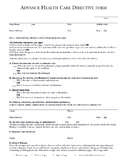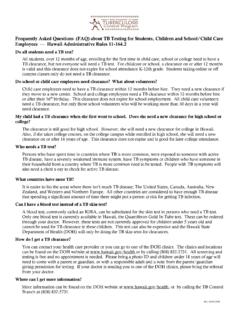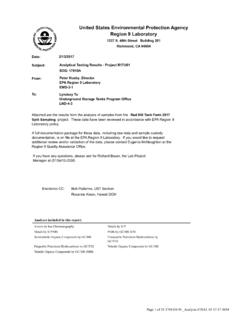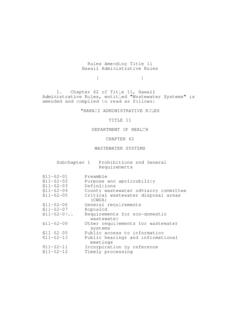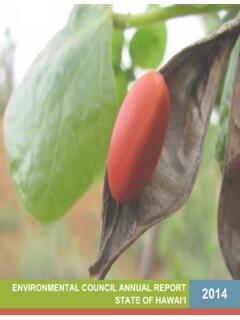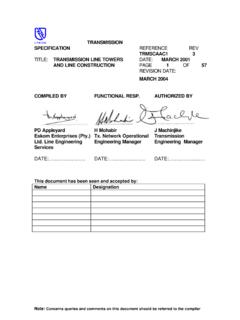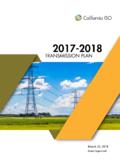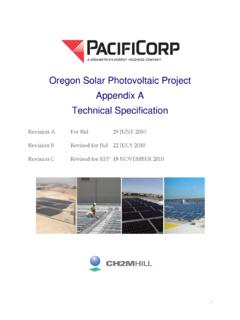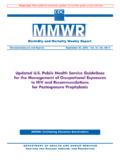Transcription of GUIDELINES FOR THE TREATMENT AND USE OF RECYCLED …
1 GUIDELINES FOR THE TREATMENT AND USE OF RECYCLED WATER Prepared by Hawaii State Department of Health Wastewater Branch May 15, 2002 (Replaces November 22, 1993 Version) Page i GUIDELINES for the TREATMENT and Use of RECYCLED Water 5/15/02 Table of Contents Chapters Sections Page I INTRODUCTION .. 1 II DEFINITIONS .. 6 III USES AND SPECIFIC REQUIREMENTS FOR RECYCLED WATER A. USES FOR R-3 WATER .. 15 B. USES FOR R-2 WATER 17 C. USES FOR R-1 WATER .. 19 D. PRECAUTIONS FOR ALL USES OF RECYCLED WATER 22 E. GROUNDWATER RECHARGE .. 27 IV TREATMENT DESIGN PARAMETERS A. TREATMENT PROCESSES .. 28 B. SECONDARY TREATMENT UNIT REQUIREMENTS 30 C.
2 COAGULATION .. 30 D. FILTRATION 33 E. DISINFECTION .. 35 F. ALARMS 37 G. POWER SUPPLY .. 38 H. FLEXIBILITY 39 I. RELIABILITY .. 40 J. OTHER METHODS OF TREATMENT 40 K. STORAGE IMPOUNDMENTS .. 41 L. EMERGENCY BACKUP SYSTEMS 42 V DESIGN PARAMETERS FOR THE DISTRIBUTION OF RECYCLED WATER A. TRANSMISSION LINES .. 43 B. PUMPING FACILITIES 45 C. ON-SITE DISTRIBUTION SYSTEMS .. 46 D. REQUIREMENTS FOR TRUCKING ALL RECYCLED WATER 50 VI ENGINEERING REPORTS AND SUBMITTALS FOR TREATMENT FACILITIES A.
3 BASIS OF DESIGN REPORT- TREATMENT FACILITY .. 52 B. ENGINEERING REPORT- TREATMENT FACILITY 56 C. CONSTRUCTION PLANS- TREATMENT 62 VII APPROVAL PROCESS FOR TREATMENT FACILITIES A. APPROVAL TO CONSTRUCT .. 64 B. CONSTRUCTION INSPECTIONS 64 C. APPROVAL TO OPERATE .. 66 D. PERFORMANCE AND COMPLIANCE INSPECTIONS 68 E. DEACTIVATION OF A TREATMENT FACILITY .. 68 GUIDELINES for the TREATMENT and Use of RECYCLED Water 5/15/02 Page ii Table of Contents (Continued) Chapter Section Page VIII ENGINEERING REPORTS AND SUBMITTALS FOR WATER REUSE PROJECTS A. BASIS OF DESIGN REPORT-WATER REUSE PROJECT 69 B. ENGINEERING REPORT-WATER REUSE PROJECT 82 1.
4 Irrigation Plan .. 82 2. Management Plan 86 3. Public Education Plan .. 88 4. Employee Training Plan 92 5. Vector Control Plan .. 94 6. Monitoring Plan 96 C. CONSTRUCTION PLANS-WATER REUSE PROJECT .. 97 IX APPROVAL PROCESS FOR WATER REUSE PROJECTS A. APPROVAL TO CONSTRUCT .. 97 B. CONSTRUCTION INSPECTIONS 97 C. APPROVAL TO OPERATE .. 98 D. PERFORMANCE INSPECTIONS 98 E. APPROVAL TO DEACTIVATE A REUSE PROJECT .. 99 F. OPERATIONAL PRECAUTIONS .. 99 X COMPLIANCE REPORTS AND SUBMITTALS A. SAMPLING AND ANALYSIS.
5 101 B. CALIBRATION 103 C. RECORD KEEPING - TREATMENT FACILITY .. 103 D. RECORD KEEPING WATER REUSE PROJECT 105 E. REPORTING PROTOCOL .. 110 Tables Title Page Table 3-1 Summary of Suitable Use For RECYCLED Water 25 Table 8-1 Nutrient Uptake Rates .. 79 Title Page Figure 4-1 TREATMENT Flow Diagram, Secondary TREATMENT Plus Direct Filtration 29 Figure 4-2 TREATMENT Flow Diagram, Secondary TREATMENT Plus Contact Filtration 31 Figure 5-1 R-2-- RECYCLED Water-Do Not Drink Wash Thoroughly With Soap and Drinking Water If Contact Occurs .. 90 Figure 5-2 R-1- RECYCLED Water-Do Not Drink .. 91 GUIDELINES for the TREATMENT and Use of RECYCLED Water 5/15/02 Page iii APPENDIX A Groundwater Management Committee.
6 A-1 APPENDIX B Ad Hoc Reuse Health Committee B-1 APPENDIX C Ad Hoc Reuse Technical Committee Members .. C-1 APPENDIX D Ad Hoc Reuse Irrigation Committee Members .. D-1 APPENDIX E GUIDELINES for Groundwater Monitoring Plan .. E-1 APPENDIX F GUIDELINES for Monitoring System Construction Report .. F-1 APPENDIX G Ad Hoc Reuse User Committee Members G-1 APPENDIX H Sample Calculations .. H-1 APPENDIX I Protocol for Reporting Spills I-1 APPENDIX J GUIDELINES for the Demonstration of Filtration Performance Criteria .. J-1 APPENDIX K UV Disinfection GUIDELINES for the Production of R-1 Water K-1 APPENDIX L Technical References .. L-1 GUIDELINES for the TREATMENT and Use of RECYCLED Water 5/15/02 Page 1 I. INTRODUCTION A combination of growing population and limited potable water resources is reducing the availability and quality of our drinking water supplies.
7 In addition, problems resulting from the disposal of wastewater continue to appear. Therefore, wastewater management practices that protect, conserve and fully utilize water resources are vital to Hawaii. Increasing the safe use of RECYCLED water can greatly assist in meeting water requirements of the State, enhance the environment, and benefit public health by preserving resources upon which public health protection is based. The Department of Health has long been an advocate for water reuse as long as it does not compromise public health and our valuable water resources. Promotion of the use of RECYCLED water is one of the Department s high priority goals. Water reuse has moderately increased in Hawaii. From November 1993 when the reuse GUIDELINES was first adopted as a policy by the Department of Health to December 2001, RECYCLED water use has more than doubled. During the past eight years, RECYCLED water use has increased from 10 MGD to 23 MGD.
8 The number of wastewater TREATMENT facilities producing RECYCLED water now totals 39 facilities. Of these 39 facilities, eleven are R-1 facilities which produce the highest quality RECYCLED water while the remaining facilities produce R-2 and R-3 waters. In an effort to assure that the reuse GUIDELINES can be properly implemented, the Department is preparing amendments to Hawaii Administrative Rule, Title 11, Chapter 62, entitled Wastewater Systems. Highlights to the proposed rule amendments that impact reuse include: Incorporating into the rule basic reuse requirements now contained in these GUIDELINES ; Including definitions for RECYCLED water as well as technical effluent requirements for RECYCLED water; Including language into the rule that excludes R-1 water spills onto the ground from enforcement actions provided Best Management Practices are implemented; Providing NPDES permit coverage for R-1 facilities in the event of an inadvertent spill into state waters; Including spill protocol revisions for R-1 water which include deleting the requirements for a) press releases; b) disinfection; and c) monitoring; and Adding language in the preamble that clearly states the Department s direction and policies regarding the use of RECYCLED water.
9 To continually keep pace with the new technical developments in the field of water reuse, the Hawaii reuse GUIDELINES are being revised. This second version continues to reflect the impact of new regulations regarding RECYCLED water in the States of California and Florida. Eight years after the publication of the reuse GUIDELINES , various sectors with reuse interest have given suggestions and recommendations to make this guideline more user GUIDELINES for the TREATMENT and Use of RECYCLED Water 5/15/02 Page 2 friendly. The Department has made every effort to incorporate those recommendations . This second version contains several new features worth noting. The Department now allows the use of R-1 water for direct contact irrigation of edible crops eaten raw. The term reclaimed water has been changed to RECYCLED water. All words referring to reclaimed have been replaced with RECYCLED in the entire text.
10 The new revised 2000 edition of the National Water Research Institute s (NWRI) ultraviolet GUIDELINES replaced the previous edition as reference for using UV as disinfection system. A new protocol for wastewater spills has been incorporated. New uses for RECYCLED water have been added. The definitions for R-1, and R-2 have been revised per the recommendations of the HWEA. The secondary plus full TREATMENT process train for the production of R-1 water has been deleted. Based on experience, direct and contact filtration TREATMENT processes have been shown to reliably produce R-1 in the State. A method of estimating evapotranspiration (ET) has been added. And finally, the requirements for groundwater monitoring have been eliminated for the underlying aquifers that are not designated as public drinking water aquifer. DOH has initiated preparation of the GUIDELINES FOR THE TREATMENT AND REUSE OF RECYCLED WATER to fill out the skeleton of existing rules with additional details in an effort to better communicate with both the design teams, RECYCLED water users and the public.

